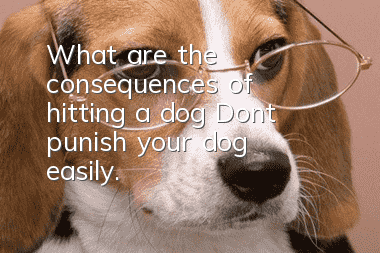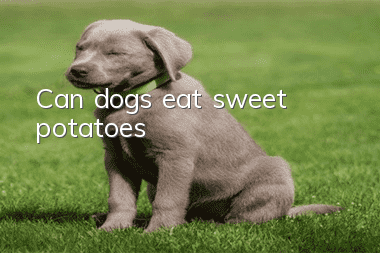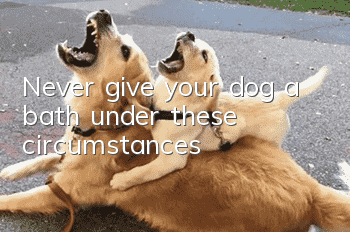What are the consequences of hitting a dog? Don’t punish your dog easily.

Punishment makes animals scared
Many people think that punishment is effective because when you punish it, the dog temporarily stops a certain behavior because of fear. You think it understands, but in fact it is not. It is just afraid. This fear will make it hide and become afraid of you, but it has no idea what you think is wrong with it. If the dog knows, it will never do it again in this life, but if you think back, which of those behaviors you have punished has really disappeared?
A dog that is punished will cower
A dog that is punished will have the mentality of "do more and make more mistakes, do less and make less mistakes, and do not do better". If you punish your dog often, it will be unwilling to do anything for fear of being punished, let alone try new behaviors. Try not to do anything to avoid being punished by you again; such a dog is very pitiful mentally. of.
Punishment will give the dog another reward
When you punish a dog, although you punish it physically and mentally, you also give it the greatest attention, that is, " Punishments and rewards coexist”. It's like a lion on the way to hunt. In order to find the antelope, it has to run on rough roads and faces the risk of being kicked by the antelope. These are all punishments for the lion, but the antelope is also the lion's biggest reward, so these punishments There is no way to stop the lion from hunting the antelope, because the reward far outweighs the punishment. The biggest reward a dog wants is not food, but your attention, so punishing your pet often fails to solve the problem, but intensifies it.
Penalty may be ineffective
Think about it, will you stop speeding just because there are speed cameras on the road? Most people still drive fast, then slow down before approaching the camera and speed up immediately after passing the camera. The study found that on road sections where speed cameras were installed, the accident rate not only did not decrease, but actually increased. Punishing two dogs for fighting will not make them stop fighting, it will just cause them to fight more fiercely where you can't see them.
Punishment will increase the fear of animals
Dogs bark because they are afraid of strangers, and punishment will make it more afraid. When a stranger shows up, even you become frightened because you punish it. The dog mistakenly thinks that strangers respect you and becomes fearful. From then on, it will become more afraid of strangers. Therefore, your punishment is not only ineffective, but also makes the dog more worried about the appearance of strangers, thus causing more serious barking behavior.
Your punishment may be wrong
Not just one thing will happen at the same time. For example, when your dog rushes to chase the postman, you shout to stop the dog. In your mind, you are punishing the dog for chasing the postman, but how can you be sure that the dog thinks so too? When it's chasing the postman, there are many factors besides it, the postman, and you.It may think, "Is it because I was too slow and didn't bite the postman that you punished me?" or "When I was chasing the postman, the neighbor's child happened to walk out. Is it because he appeared at this time?" I was punished by you?"
Don’t think about things from your perspective. If you are trying to solve a dog’s behavioral problem, look at things from their perspective.
Punishment leads to luck
Punishment often leads to luck, just like when you buy lottery tickets, you buy a hope. Failure to win is a punishment, and winning is a reward. When you punish your dog for digging through the trash can, it will have a sense of luck, because there is a "Lottery" in the trash can. If you find it when you go through the trash can, it is a punishment. Discovery is “winning the lottery.” So, going through the trash can turned into searching for a "hope". If you continue to use punishment to solve the problem, it will never be solved.
Punishment may cause injuries to animals
You don’t know how much force a dog can withstand, and you can’t control your own force. Especially when you punish an animal, you lose some control over your “emotions” and often punish excessively. , resulting in pet injury or death!
Punishment will make dogs lose their desire
If you are scolded by your boss no matter what you do when you go to work, you will lose your desire to work because you are afraid of making mistakes and may even be at a loss what to do. The same goes for dogs. If you punish it often, it will not know how to give you a life, it will be at a loss, and it may even lose trust in you.
Punishment can cause you injury
You must know that not every animal faces punishment and suffers it silently. Many animals will fight back in order to protect themselves, so don't assume that the dog you punished before has endured it, and this dog will accept it now. When a dog fights back in order to protect itself, it is not just for show. It will fight back with all its strength, often causing you to be injured.
Think about it, what is your original intention of raising a dog? For the love of it? Or to punish it? Don't punish the animal because you can't find a solution. Punishment only shows your helplessness.
Please use rewards (positive reinforcement) instead of punishment! When faced with a dog's behavior problem, you can think: "What can I do to guide it to do the right thing and then reward it?" If you can't find a way, you can use a qualified and certified trainer to help you solve the problem easily. .
All animals are driven by three things:
①Food
②Avoid danger and pain
③The need to reproduce offspring
So we use these three methods to drive dogs, but it is not practical to drive them based on the need to reproduce; making them afraid or in pain can drive them, but it will cause more problems. Please do not use this method. Therefore, the fastest, most effective way without harming the dog is to use food rewards!
The most effective method that does not harm the dog is to use food rewards
In order to know more clearly what can effectively drive the dog, we can use "easy-to-occur reactions that can be strengthened" Reaction that is not likely to occur" is the principle. And it doesn't necessarily require physical reinforcements (Reinforcers), such as food or bones. Because the most powerful reinforcing substances are things that dogs are more willing to do. For example, a dog may want to play with other dogs during a walk rather than eat snacks. In this case, play is more effective than food, but in the case of distance from other dogs, food is more effective than play. Reinforcing substances will vary significantly depending on the dog's state, or changes in state before and after.
So, we can change the strength of the reinforcing material by changing the dog's state. Taking the previous example, after the dog complies with the "come" request, we can untie the leash and let it play, and use "let it play" as a reward.
If you want to know which reward your dog wants most, you have to observe more
Even if a dog loves to eat, under certain conditions, it may not want it. Food, and your caress and attention to it, is the greatest reward. So, don’t just list the things your dog likes, but also observe his reactions. We often ignore the information dogs convey to us, and it is easier to ignore the most important thing: dogs are analyzing your every move anytime, anywhere! If you're not paying close attention to your dog, it's easy to choose the wrong reward. For example, you talk a lot to your dog, thinking that it likes you talking to it, but in fact it is because you happen to have a toy in your hand, and the dog is happy because of the toy.
At this time, the best reward is not your praise, but the toy in your hand. Or you are clearly petting it, but it pays attention to the snacks in your pocket. At this time, the best reward material is food. Therefore, before you start teaching and guiding your dog, you must first learn to "make good use of appropriate reward materials" in order to effectively drive your dog.
Whether you are an ordinary dragon owner or a trainer, you need to pay attention to a few points when using rewards in different situations:
1. Not every animal is suitable for training the same movements. . For example, golden sheep and goats, such asIf you want to train to climb mountains, even if the sheep looks the same as a goat after shaving its hair, it will not become better at climbing than the goat. Therefore, when training a dog, try to train according to its characteristics as much as possible, and do not excessively ask it to achieve the "impossible task" you set.
2. When using rewards, you must also pay special attention: there will not be only one thing happening at the same second. So, what behavior are you rewarding? For example, if you ask your dog to come to you, and it walks slowly, you take out snacks for it to eat, and while eating, it happens to sit down. In this way, what you may reward is not the "come" behavior. It’s the act of “sitting down.” Or before you took out the snack, although it had already walked in front of you, it turned its head because it heard a sound outside the door, and its eyes happened to be looking at the door. Then you gave it the snack, and the reward was not "coming". behavior, but to "look at the door" or "turn your head."
- golden retriever pregnancy process
- What should I do if my dog doesn’t eat the new dog food?
- How to train an aggressive dog? Train a very aggressive dog!
- What should I do if my dog has dystocia? A must-read for emergency measures for dog dystocia!
- What are the symptoms of canine distemper in dogs? The early symptoms of canine distemper!
- Symptoms and treatment methods of epilepsy in dogs
- Do dog owners need to be vaccinated?
- The Origin and History of the Australian Cattle Dog
- Simple methods and precautions for making homemade dog food
- What training method should you choose to train your dog? How to get good results



